My long term observations is that: These bankrupt nations/failed States have caused a sudden drastic currency depreciation, outflow of capital, and massive inflation (cost of living stress), stock and property price drop etc. They are all linked to the United States (incredible and reckless) massive money printing. As well as the Unites States reserve Bank's interest rate rise. This is how (in the past) the American regime would end up periodically looting the world. Not just the world, but friends and enemies alike, including its own allies. Doing so without any military action. This is a complex topic. Now, the Chinese CCP studied how this US policy works. And now, this time, China is so well prepared that there are basically no inflation in China. At all. This time, when the US regime ran this old technique again, the EU is seriously and badly affected. What are they to do? Well, it's obvious. Watch the outflow of currency. Indeed, a large portion of EU money is flowing to China as safe heaven instead of to the USA. As a result, the United States suffered catastrophic inflation domestically... ... and, in regards to China, it completely lost it effectiveness as a tool of chaos, control and power. Cheers Chua
Here we go through the motions as our idiotic Western governments invite nuclear war upon the world.
President of Serbia: “All Hell is About To Break Loose in Ukraine” – World War 3 is Already happening

The Ukraine conflict is in fact already a world war, given that the West is fighting Russia via its proxies in Kiev, Serbian President Aleksandar Vucic told local media on Wednesday.
“We should understand that amid the world war – because all the talks that it is a regional or a local war must be dropped – the entire Western world is fighting against Russia via Ukrainians. It is a global conflict,” he said in an interview with Pink TV.
The president said that the ongoing global war is what concerns him the most, and, in his view, it will only get worse. He also added that the conflict in Ukraine is taking its toll on the Balkans, reiterating that Serbia would do its best to keep the peace in the region.
Moreover, Vucic believes that after Russia gains some more ground in eastern Ukraine, President Vladimir Putin will approach the West with a certain “proposal.”
“I know what awaits us. As soon as Vladimir Putin has done his work in Seversk, Bakhmut and Soledar, after reaching the second line Slaviansk-Kramatorsk-Avdeevka, he will come up with a proposal. And if they [the West] don’t accept it, – and they won’t – all hell will break loose,” he predicted, without providing any details on the would-be initiative.
The Serbian president also offered the reminder that his nation maintains close relations with Russia and China, adding that pursuing such policies does not come easy for Belgrade right now.
Vucic’s comments come after Serbian Interior Minister Aleksandar Vulin said in early July that the West should apologize to Belgrade for the 1999 bombing campaign instead of forcing it to become a “NATO foot soldier” in the conflict with Russia.
Threads – 10 minutes of the bunker scenes
Yeah. This is the real deal. Soak it up.
Tender and Militant: Artist Sung-Choul Ham and His South Korean Fantasy Worlds

Sung-Choul Ham is an artist from South Korea, he draws illustrations and concepts (mostly fighting anime girls) for games and movies. He’s currently working at Majors Studio where he’s developing characters for South Korean fantasy MMORPGs and he’s doing a great job.





















U.S. Railroad Strike Begins July 18 – Trains will stop
The Brotherhood of Locomotive Engineers and Trainmen (BLET) voted by a margin of 99.5 percent to authorize a strike if such action becomes legal and “necessary to secure a contract worthy of their consideration.” A strike like this threatens to halt all train movement across the country.
In a statement, BLET National President Dennis Pierce said that this is the first nationwide strike vote since 2011, but that it is necessary because railroads “used and continue to use their economic strength to steamroll their employees, their customers and the nation, all for the sake of their bottom line, and it is clear that they have no intentions of changing.”
In the third year of the national contract negotiation process, he added, “the rail carriers have never made a contract proposal to our union that their employees, our members, would accept.”
The moment trains stop, all the supply-chain issues previously experienced by Americans, will grow worse by orders of magnitude.
Egg Salad
This salad takes some work, but if you don’t mind peeling a few eggs, you can enjoy this family-friendly, budget-conscious hearty salad. Mustard and paprika give it that extra kick.

Ready for something fantastic and easy? You’re in luck! This is a classic egg salad recipe, just like Grandma used to make! Sit down with it for a quick lunch … or chow down for dinner at any time as the weather gets warmer.
I know what you may be thinking … “This is such a classic! I have my own recipe passed down through the generations. Doesn’t everyone?!” To that, I answer, tradition is wonderful, but just give this one a try! It’s my own perfected egg salad recipe that you’ll simply adore. You may even use it to tweak the recipe that’s been in your family forever! It’s that amazing: creamy, eggy, and full of crisp onions and celery. So good!

And if you’ve never made egg salad before? Don’t despair!! This egg salad recipe is very, very easy. In fact, there are only a few steps: five steps to hardboil the eggs and three steps to put together the salad itself. The ingredients are the kind you can find at any store, and it lasts 3-5 days in the fridge (if you’re lucky enough to have leftovers!). If you’re someone who doesn’t have a traditional family egg salad recipe, well, here you go with your new family recipe!
Egg Salad Recipe
- large eggs
- mayonnaise
- yellow mustard
- green onion
- celery
- salt
- ground black pepper
- paprika
Note: Make sure your eggs are fresh for this recipe! Expired eggs will float to the top of the water when you try to cook them, but a fresh egg will sit neatly at the bottom of the pan on its side.

How To Make Egg Salad
Time needed: 30 minutes.
How To Make Egg Salad
- Add the eggs to a medium saucepan. Add cold water to a level where it is just covering the eggs.
- Bring water to a boil and immediately remove from heat. Cover and let the eggs stand for 15 minutes.
- Remove the eggs to a large bowl with ice water and let the eggs cool.
- Peel and chop the eggs and place them in a medium bowl.
- Add the remaining ingredients and mix well.
- Spread the egg mixture on your favorite bread or crackers, or serve on lettuce or in a wrap!

I am in Pennsylvania . . .
I am at the house I inherited in Pennsylvania. My wife did not come.
We’re trying to work things out.
Maybe she’ll come up next week.
I told her I feel that Russia is going to attack the United States with a nuclear first strike over our helping Ukraine kill Russian soldiers.
I told her that I believe New York City is a major target for such a first strike, because it will cripple the nation’s banking industry and stock markets.
I told her that Russia uses what they call the “YARS” missile for such attacks, and that each missile carries a warhead with an eight hundred kiloton (800kt) yeild.
I explained that such bombs are usually air-burst about 2900 meters (1.5 Miles) above a target.
With our condo being located just 3 miles west, southwest of the Empire State Building in midtown Manhattan, our condo would not survive and neither would anyone in it.
At the initial blast, the bright, white, flash would instantly cause temperatures outside our front door of over one-hundred-thousand degrees. The entire building would burst instantly into flames. Then comes the blast wave from the air being pushed by the explosion. Thousand mile per hour winds causing an “over-pressure” of about 30,000 p.s.i. would crush the building into a burning pile of rubble in seconds.
I told her there is no way any of us would have any chance at all of surviving; that we would die a horrible fiery and crushing death within seconds.
I also showed her the PSA put out this week by NYC Emergency management, telling people what to do if a nuke hits NYC., and I showed her the new warning signs going up in shopping centers in New Jersey warning people of what to do in a “Radiation Emergency.”
I told her that the US Dept. of Homeland Security is the one paying to put those signs up because they KNOW what’s coming.
She said she has some things to do and some Doctors to see, but maybe she’ll come up later next week.
I said, fine, I just want you to understand that if Russia launches, their missiles can get here before I can get from Pennsylvania to New Jersey. I won’t be able to save her.
She understood.
So that’s where we are.
I won’t go into the marriage issues that caused such an upheaval last Friday that I couldn’t do a show. Suffice it to say things are bad.
How bad?
I took off my wedding ring.
That bad.
Hal
I feel really bad for this guy. I hope that things calm down and settle down. Be good to each other, and remember that it is your family and friends that are you greatest strength during these times of great stress. -MM
A most Japanese thing…

Japan has a strict rule when you’re job hunting, especially for university students.
They all have to wear what is called recruit suit.
This is the basic black suit, white shirt, black business bag and black dress shoes. It has to be the standard design and length. Hair should be dyed black. There is a range of color of black dyes that are acceptable. For women, hair should be tied into a ponytail. For men, it should be cut short and professional-looking.
Clothing shops selling suits and businesswear sell these recruit suits every hiring season. You’ll see ads and posters all around Japan.
You should blend in together with the rest of the applicants. It will be disastrous for your application if you stray from these rules.
Very Japanese thing.
In Eurasia, the War of Economic Corridors is in full swing
Mega Eurasian organizations and their respective projects are now converging at record speed, with one global pole way ahead of the other.
By Pepe Escobar, posted with permission and cross-posted with The Cradle
The War of Economic Corridors is now proceeding full speed ahead, with the game-changing first cargo flow of goods from Russia to India via the International North South Transportation Corridor (INSTC) already in effect.
Very few, both in the east and west, are aware of how this actually has long been in the making: the Russia-Iran-India agreement for implementing a shorter and cheaper Eurasian trade route via the Caspian Sea (compared to the Suez Canal), was first signed in 2000, in the pre-9/11 era.
The INSTC in full operational mode signals a powerful hallmark of Eurasian integration – alongside the Belt and Road Initiative (BRI), the Shanghai Cooperation Organization (SCO), the Eurasian Economic Union (EAEU), and last but not least, what I described as “Pipelineistan” two decades ago.
Caspian is key
Let’s have a first look on how these vectors are interacting.
The genesis of the current acceleration lies in Russian President Vladimir Putin’s recent visit to Ashgabat, Turkmenistan’s capital, for the 6th Caspian Summit. This event not only brought the evolving Russia-Iran strategic partnership to a deeper level, but crucially, all five Caspian Sea littoral states agreed that no NATO warships or bases will be allowed on site.
That essentially configures the Caspian as a virtual Russian lake, and in a minor sense, Iranian – without compromising the interests of the three “stans,” Azerbaijan, Kazakhstan and Turkmenistan. For all practical purposes, Moscow has tightened its grip on Central Asia a notch.
As the Caspian Sea is connected to the Black Sea by canals off the Volga built by the former USSR, Moscow can always count on a reserve navy of small vessels – invariably equipped with powerful missiles – that may be transferred to the Black Sea in no time if necessary.
Stronger trade and financial links with Iran now proceed in tandem with binding the three “stans” to the Russian matrix. Gas-rich republic Turkmenistan for its part has been historically idiosyncratic – apart from committing most of its exports to China.
Under an arguably more pragmatic young new leader, President Serdar Berdimuhamedow, Ashgabat may eventually opt to become a member of the SCO and/or the EAEU.
Caspian littoral state Azerbaijan on the other hand presents a complex case: an oil and gas producer eyed by the European Union (EU) to become an alternative energy supplier to Russia – although this is not happening anytime soon.
The West Asia connection
Iran’s foreign policy under President Ebrahim Raisi is clearly on a Eurasian and Global South trajectory. Tehran will be formally incorporated into the SCO as a full member in the upcoming summit in Samarkand in September, while its formal application to join the BRICS has been filed.
Purnima Anand, head of the BRICS International Forum, has stated that Turkey, Saudi Arabia and Egypt are also very much keen on joining BRICS. Should that happen, by 2024 we could be on our way to a powerful West Asia, North Africa hub firmly installed inside one of the key institutions of the multipolar world.
As Putin heads to Tehran next week for trilateral Russia, Iran, Turkey talks, ostensibly about Syria, Turkish President Recep Tayyip Erdogan is bound to bring up the subject of BRICS.
Tehran is operating on two parallel vectors. In the event the Joint Comprehensive Plan of Action (JCPOA) is revived – a quite dim possibility as it stands, considering the latest shenanigans in Vienna and Doha – that would represent a tactical victory. Yet moving towards Eurasia is on a whole new strategic level.
In the INSTC framework, Iran will make maximum good use of the geostrategically crucial port of Bandar Abbas – straddling the Persian Gulf and the Gulf of Oman, at the crossroads of Asia, Africa and the Indian subcontinent.
Yet as much as it may be portrayed as a major diplomatic victory, it’s clear that Tehran will not be able to make full use of BRICS membership if western – especially US – sanctions are not totally lifted.
Pipelines and the “stans”
A compelling argument can be made that Russia and China might eventually fill the western technology void in the Iranian development process. But there’s a lot more that platforms such as the INSTC, the EAEU and even BRICS can accomplish.
Across “Pipelineistan,” the War of Economic Corridors gets even more complex. Western propaganda simply cannot admit that Azerbaijan, Algeria, Libya, Russia’s allies at OPEC, and even Kazakhstan are not exactly keen on increasing their oil production to help Europe.
Kazakhstan is a tricky case: it is the largest oil producer in Central Asia and set to be a major natural gas supplier, right after Russia and Turkmenistan. More than 250 oil and gas fields are operated in Kazakhstan by 104 companies, including western energy giants such as Chevron, Total, ExxonMobil and Royal Dutch Shell.
While exports of oil, natural gas and petroleum products comprise 57 percent of Kazakhstan’s exports, natural gas is responsible for 85 percent of Turkmenistan’s budget (with 80 percent of exports committed to China). Interestingly, Galkynysh is the second largest gas field on the planet.
Compared to the other “stans,” Azerbaijan is a relatively minor producer (despite oil accounting for 86 percent of its total exports) and basically a transit nation. Baku’s super-wealth aspirations center on the Southern Gas Corridor, which includes no less than three pipelines: Baku-Tblisi-Erzurum (BTE); the Turkish-driven Trans-Anatolian Natural Gas Pipeline (TANAP); and the Trans-Adriatic (TAP).
The problem with this acronym festival – BTE, TANAP, TAP – is that they all need massive foreign investment to increase capacity, which the EU sorely lacks because every single euro is committed by unelected Brussels Eurocrats to “support” the black hole that is Ukraine. The same financial woes apply to a possible Trans-Caspian Pipeline which would further link to both TANAP and TAP.
In the War of Economic Corridors – the “Pipelineistan” chapter – a crucial aspect is that most Kazakh oil exports to the EU go through Russia, via the Caspian Pipeline Consortium (CPC). As an alternative, the Europeans are mulling on a still fuzzy Trans-Caspian International Transport Route, also known as the Middle Corridor (Kazakhstan-Turkmenistan-Azerbaijan-Georgia-Turkey). They actively discussed it in Brussels last month.
The bottom line is that Russia remains in full control of the Eurasia pipeline chessboard (and we’re not even talking about the Gazprom-operated pipelines Power of Siberia 1 and 2 leading to China).
Gazprom executives know all too well that a fast increase of energy exports to the EU is out of the question. They also factor the Tehran Convention – that helps prevent and control pollution and maintain the environmental integrity of the Caspian Sea, signed by all five littoral members.
Breaking BRI in Russia
China, for its part, is confident that one of its prime strategic nightmares may eventually disappear. The notorious “escape from Malacca” is bound to materialize, in cooperation with Russia, via the Northern Sea Route, which will shorten the trade and connectivity corridor from East Asia to Northern Europe from 11,200 nautical miles to only 6,500 nautical miles. Call it the polar twin of the INSTC.
This also explains why Russia has been busy building a vast array of state-of-the-art icebreakers.
So here we have an interconnection of New Silk Roads (the INSTC proceeds in parallel with BRI and the EAEU), Pipelineistan, and the Northern Sea Route on the way to turn western trade domination completely upside down.
Of course, the Chinese have had it planned for quite a while. The first White Paper on China’s Arctic policy, in January 2018, already showed how Beijing is aiming, “jointly with other states” (that means Russia), to implement sea trade routes in the Arctic within the framework of the Polar Silk Road.
And like clockwork, Putin subsequently confirmed that the Northern Sea Route should interact and complement the Chinese Maritime Silk Road.
Russia-China Economic cooperation is evolving on so many complex, convergent levels that just to keep track of it all is a dizzying experience.
A more detailed analysis will reveal some of the finer points, for instance how BRI and SCO interact, and how BRI projects will have to adapt to the heady consequences of Moscow’s Operation Z in Ukraine, with more emphasis being placed on developing Central and West Asian corridors.
It’s always crucial to consider that one of Washington’s key strategic objectives in the relentless hybrid war against Russia was always to break BRI corridors that crisscross Russian territory.
As it stands, it’s important to realize that dozens of BRI projects in industry and investment and cross-border inter-regional cooperation will end up consolidating the Russian concept of the Greater Eurasia Partnership – which essentially revolves around establishing multilateral cooperation with a vast range of nations belonging to organizations such as the EAEU, the SCO, BRICS and ASEAN.
Welcome to the new Eurasian mantra: Make Economic Corridors, Not War.
You’re a disaster
An outstanding commentary by a former Pentagon Advisor to the US President, commenting on what he would tell President Biden…
The story of emperor of China, “Wu of Jin”
At the end of his reign as emperor of China, “Wu of Jin” brought more than 5,000 women to his palace.
From that moment on, the emperor concentrated on celebrating and enjoying women, rather than on important matters of state.
It was said that there were so many beautiful women in the palace that he literally did not know who he should have sex with; therefore, he came up with a rather… “particular” solution.
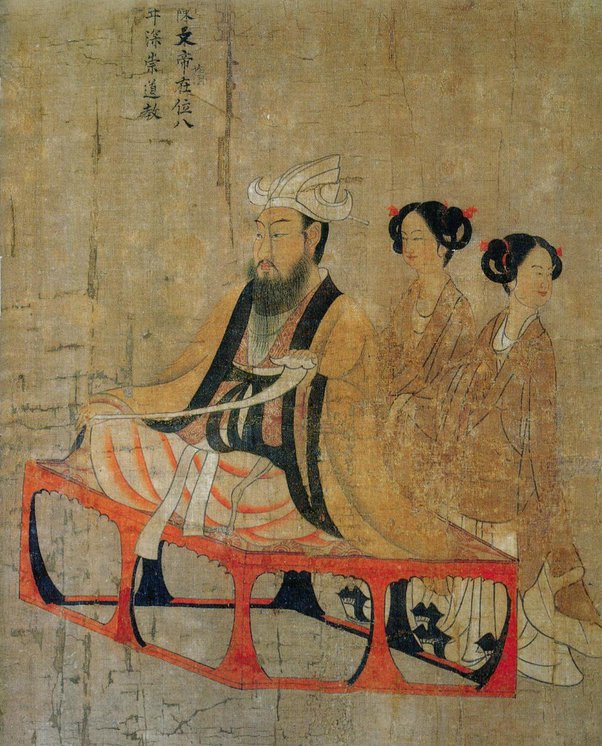
Every day he walked inside the palace in a small wooden carriage powered by goats, if the goats stopped in front of any woman, that was the one the emperor chose.
Because of this, many of the women planted bamboo leaves outside their bedrooms, in order to attract the goats.
This, I assure you, will not appear in any of your history books.
What does Spain do better than the US?
From my Q Feed…
I’m 23 and I’m from California, USA but I’ve lived in Barcelona collectively for a year now. I work remotely with clients across Europe and the States.
There are quite a few things that keep me here.
Socially, I’m less isolated, less alone, more included despite my horrific Spanish.
I noticed immediately when I moved here how much more social and communal my days became. I had lived in New York City before coming here. One of the most crowded, diverse cities in the world and proclaimed ‘city that never sleeps’, made me feel the most isolated.
Anytime there is free time here, every night of the week, there is someone inviting me to just sit and get coffee or a drink. In the US, it would take me three weeks to see as many friends I catch up with here in three days. Plans are easy and people take time to interact. I’ve noticed how much happier everyone else is, including myself.
The more relaxed mentality counteracts my workaholic bs.
Both my parents are entrepreneurs as am I. I went to a competitive business school in Dallas, Texas. Stressed is a default setting for me. And to some degree, that’s been beneficial. But moving here and being surrounded by people who will tell me I’m over doing it and need a drink is absolutely priceless. I’ve actually noticed a difference in how I physically feel and physically how the day “looks” to me; more light and not so impacted even if I am still working a lot. A collective, calmer energy around me is really helpful.
They dress better and now I dress better.
Where I’m from, the standard look is work out clothes everyday and if you put on even so much as jeans people ask you where you’re going. My university in Texas was worse. Here, an actual adult outfit is what’s expected. Everyone looks nice. Of course, within about three days I went shopping and got my shit together. I actually feel more confident and put together when I’m here because of that social standard.
They eat better and now I eat better.
I find it so much easier to eat healthier here. The mediterranean diet is inescapable. At home, there is kind of this half-assed healthy/convenience diet everyone, myself included strives for. You might know what I’m talking about. I’m no longer living off Diet Coke and protein bars. Which is great. Meal time is taken a little more seriously here so I cook and put a lot more conscious thought into my food.
Social barriers we have in the States do not exist.
I have friends who are senior managers at Deloitte that are also best friends with waiters. No one cares. No. One. Cares. Career is not the main topic of conversation or what people align their lives around. It’s simply how you make money to be able to go out and drink with your friends whoever they may be. This was way different for me. My whole life is my business and I came from cities where everyone’s social circles revolves around their jobs. I really love it. There are more perspectives and understanding.
Anyways, I just spent a few months back in the US getting a new visa. Of course there are things about the US that are very much engrained in me that I believe have made me who I am and I love that. There will always be things I love about home. Right now, Spain is showing me things about myself and other perspectives I can really appreciate.
We’re learning more than ever about war from the Ukraine
By <name withheld>
That is, if you follow closely what is happening.
We see that it is brutal beyond our imagination. Our imagination fails
because for the last 30 years the Western Media’s main job was to
Ignore, Deny and Justify the daily carnage dealt out to “Brown-Skins”.
There were some Eastern Europeans in there too, but call them Commies.
Now the Western Media job is to report every nuance, and even invent
most of the stories to give their “reporting” a flare. Every atrocity
they report has already been happening for 3 decades, but the official
position is that we really didn’t care. Let “Democracy” do its work.
We see that the worst travesty on earth is what they call the proxy
war. Opposing “great” powers hire third world discontents to perform a
chicken (cock) fight, and the powers sit on the sidelines making their
bets. The person could probably make $10/day in their home country.
(Like the Ukraine average), If they can get an honest job. Or they can
push drugs and engage with crime and make more (like in Ukraine).
But on the battle field they are promised $50/day, sometimes even
$100/day, (but then are usually paid less). All they have to do is kill
some people. And most of the times it’s unarmed civilians. It is kind
of like a sports club or a fraternity. Make a few IED’s. Not quite the
same in today’s war.
In the Ukraine one side is proxy, (with their own people of course, but
with proxy armaments). The Ukrainian military is not paid any premium,
but their pay is sent in by proxy. And the other side, Russian allies,
are working for their own security against the proxy sponsors. (It is
a very interesting dynamic, that I can comment on, but not in this piece.)
The Ukraine used to have all the cities except those occupied the LPR
and DPR. They had 8 years to fortify them and stock military supplies,
according to their battle plan. Now they have lost much of that
territory plus a land bridge from Russia to the Crimea, Kherson and the
like. Therefore we can conclude by this movement, that Russia is on the
offensive and Ukraine on the defensive. Today I am not counting Russia’s
drive toward Kiev. Maybe it was just an experiment to see if things
could happen easy, without much loss of life. I find it honorable.
The offensive side controls the battle plan and the speed and direction
of the attacks. The defense has to absorb what the offense doles out to
them. The offense can easily go back and forth, with the objective to
save their lives. The defense cannot go back (unless they must), and
the lives lost can make NO DIFFERENCE.
Too many commenter’s claim the battle is stalled out. So Russia must be
hurting, because it doesn’t go forward according to MY (the commenter’s)
CONCEPT. Not to Russia’s plan? But if you look closely, on each day
that the front lines don’t move, many hundreds of Ukrainian soldiers are
killed, (each day) and many dozens of their heavy equipment destroyed.
It is through stand-off artillery not face to face combat, so the losses
are not equal. It is said that 50% of Ukrainian BTG’s have heavy
losses, one up to 80%. Can you imagine what it feels like to be in a
BTG of 900 soldiers and now there are only 180 left? Unfortunately, in
war, many countries understand only body counts. I think the USA is
like that.
So the mistake is to judge the war only by movement on the front. Asking
what major cities have been taken?
So far this war is to liberate the Ex-Russian, the Russian speaking
population from under the fascist regime. So the goal is to preserve
their lives, and allow them to build a productive society in the
future. We won’t know about the non-Russian speaking population until
they get there. You can’t just take a poll to ask what they think.
They are not allowed to express any doubt, under severe fascist
penalties, including death. If they are liberated, many might choose to
live far away from the Kiev regime. So you don’t want to kill or maim
those civilians either. Maybe by the time you get to Lvov, you can
take off the kid gloves.
Here are some ugly truths of life.
1. Not all relationships will lead to marriage, some will help you discover new restaurants.
2. It’s not selfish to make your happiness your main priority.
3. Stay away from “still” people. Still broke, still complaining, still hating, still nowhere.
4. Anything that costs you your mental health is too expensive.
5. Make sure you’re not the only one who actually values the connection.
6. You don’t have to be liked by everybody. You don’t even like everybody.
7. People may be upset when you choose you over their mess. Choose you anyway.
8. Listen, that move you are scared to make, might be the game changer.
9. There is a past version of you that is so proud of how far you have come.
10. If someone’s absence brings you peace. You didn’t lose anything.
Iran, Argentina apply to join BRICS bloc after recent summit: Report
Ahead of the summit, Saudi Arabia too expressed interest to join the grouping, according to reports.
From HERE
Every nation is "abandoning the USD" and "abandoning the West" and getting on board with the united Asia. -MM
Iran and Argentina have applied to join the BRICS mechanism, the Russian state media reported, days after a summit of the five-nation bloc during which the leaders agreed to continue to discuss the possibility of admitting new countries to the grouping on the basis of “full consultation and consensus.”
Argentina and Iran have applied for joining BRICS (Brazil, Russia, India, China, and South Africa), Russian Foreign Ministry Spokeswoman Maria Zakharova was quoted as saying by the state-run Tass news agency.
It reported that Iranian Foreign Ministry spokesman Saeed Khatibzadeh said on Monday that Tehran has applied for BRICS membership.
Tehran filed the application for accession to the BRICS, he said.
The diplomat expressed hope that “Iran will be able to contribute to the BRICS’ operation and benefit the organisation.”
Argentina’s President Alberto Fernandez said at a BRICS+ meeting last week that his country wants to become a full member of the association, the Tass report said.
Ahead of the summit, Saudi Arabia too expressed interest to join the grouping, according to reports.
The issue of expansion of the BRICS bloc was figured in the June 23 virtual summit hosted by China, which is this year’s chair.
The declaration issued at the end of the summit said the leaders will continue to discuss the possibility of admitting new countries to the five-nation grouping on the basis of “full consultation and consensus.”
Asked for his reaction at a media briefing here on Tuesday about Iran and Argentina applying to join BRICS, Chinese Foreign Ministry spokesman Zhao Lijian said many countries have expressed their interest to join the five-member bloc of emerging markets.
“BRICS countries agreed that it is important to step up cooperation with other emerging markets and developing countries to improve the representativeness of the BRICS mechanism and make it loudly heard on major international issues so that we can better rise up to challenges and uphold the interests of emerging markets and developing counties,” Zhao said.
“We have noted that many countries including Iran and Argentina have expressed their willingness to join the BRICS family. As the chair of the BRICS this year China actively supports BRICS countries to start the membership expansion process to expand BRICS Plus cooperation,” he said.
Zhao said that at the 14th summit held on June 23 the BRICS leader made a unanimous voice on the expansion of the BRICS mechanism and they supported discussion, standards and procedure for the expansion.
“China will work with BRICS partners to move ahead with the expansion process steadily so that like-minded partners can join the BRICS family,” he said.
“We shall continue to set clear priorities in our wide-ranging cooperation, on the basis of consensus, and make our strategic partnership more efficient, practical and results-oriented,” the declaration said.
“We support promoting discussions among BRICS members on BRICS expansion process. We stress the need to clarify the guiding principles, standards, criteria and procedures for this expansion process through Sherpas’ channel on the basis of full consultation and consensus,” it said.
In Case You Were Wondering Why Inflation Has Started To Spiral Wildly Out Of Control…
When you keep making horrible decisions, eventually the consequences are going to catch up with you. That is true for individuals, and it is also true for entire nations. Here in the United States, previous generations handed down to us the strongest and most stable national currency on the planet. Having the default reserve currency of the world has been a great blessing, because it has enabled us to enjoy a standard of living that is far greater than we actually deserve. But instead of doing their best to preserve and protect our currency, our leaders have decided to systematically destroy it instead. As a result, the rate of inflation has gotten completely out of control, and many experts are extremely concerned about what lies ahead.
It doesn’t take a genius to figure out why we have such a problem with inflation at this point.
The money supply has ballooned to levels that were once unthinkable, and this is going to cause massive problems for the foreseeable future.
Let me show you what I am talking about. The following chart of how M1 has changed over the years comes directly from the Federal Reserve…
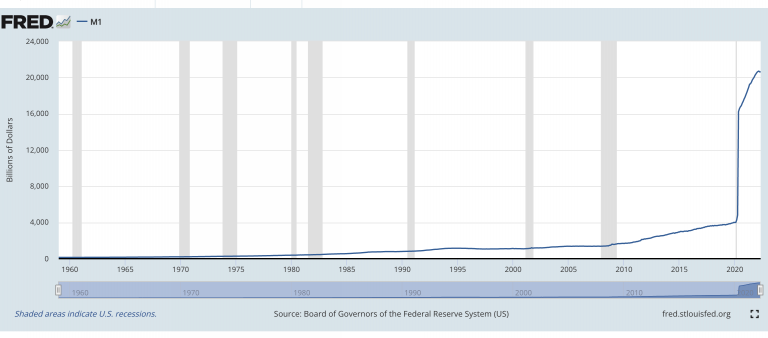
The giant spike that you can see on the chart started during the early stages of the COVID pandemic.
Our leaders abandoned any pretense of restraint, and we went “full Weimar” for about two solid years.
I warned over and over again that what we were doing was absolutely insane, and now we are starting to experience the consequences.
Many people believe that M2 is a much more accurate measure of the money supply than M1 is, and so let me show you a chart of how M2 has changed…
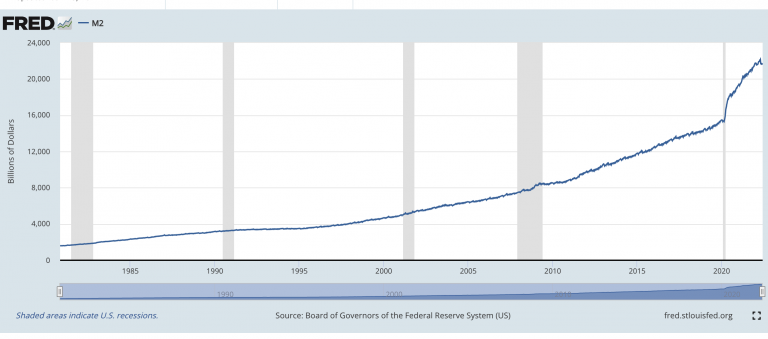
This chart certainly looks better than the previous one, but it is still extremely frightening.
We are rapidly destroying the stability of our currency, and as a result our standard of living is being absolutely shredded.
I’ll give you an example. A young lady down in Texas went viral this month when she revealed that she was living in a shed in a desperate attempt to save money…
A young Texas woman who moved into a shed that she purchased for just $2,000 in order to save money amid the housing crisis has opened up about her desperate struggle to cope with the summer heat while living in the property – which has no AC or shower.
Is this what they mean when they tell us that we are going to “own nothing and be happy”?
Apparently she was promised that the shed would be “fully livable”, but she quickly found out that wasn’t exactly true…
However, in a video shared to her TikTok, which gained over one million views, Elizabeth revealed that she was ‘ripped off by the builders’ because she was under the impression it was a fully livable shed and is ‘dying’ in the Houston heat while thinking about how ‘nice’ a shower would be.
The good news is that her father came down from South Carolina and installed lights and air conditioning.
So now Elizabeth and her boyfriend will be able to cool off during the summer months.
But they still have no way to bathe.
Sadly, the truth is that they are far better off than hundreds of millions of others around the globe right now.
As energy costs and food costs go absolutely haywire, we are starting to see widespread civil unrest in various parts of the world.
For example, check out what is currently going on in Sri Lanka…
The political crisis triggered by months of socialist economic collapse in Sri Lanka continued on Wednesday with violent clashes between protesters and soldiers, resulting in upwards of 80 people hospitalized in one day and the military announcing soldiers were “empowered” to attack civilians if deemed necessary. The Democratic Socialist Republic of Sri Lanka, governed for the better part of the past two decades primarily by the populous Rajapaksa family, began to run out of food, medicine, oil fuels, natural gas, and nearly every other basic good in March, the result of lavish government spending and the imposition of “green” policies that banned chemical fertilizer use.
They promised us that the “green revolution” would change everything, and they were right.
Things are starting to get really crazy in Albania too.
And what we are witnessing in Panama right now is extremely alarming.
All over the globe, energy and food are traded in U.S. dollars.
When interest rates rise in the U.S., the dollar tends to go up relative to other global currencies, and that makes things much harder for those at the very bottom of the economic food chain.
Unfortunately, in a desperate attempt to get inflation under control in the U.S., the Federal Reserve has been aggressively raising interest rates.
And we are now being warned that the Fed could raise rates “by a full percentage point” at the next meeting…
Investors see a growing probability that the Federal Reserve could hike interest rates by a full percentage point at its next meeting for the first time in the modern era. In June, the Fed raised interest rates by three-quarters of a percentage point, which it hadn’t done since 1994.
Considering the fact that we are plunging into a recession, it would be absolutely insane for the Fed to do such a thing.
But they seem quite serious about making another big move.
In fact, the head of the Atlanta Fed just publicly told us that “everything is in play” at the next Fed gathering…
Atlanta Federal Reserve Bank President Raphael Bostic said Wednesday that “everything is in play” when asked about the prospect of the central bank raising interest rates by a full percentage point later this month, expressing concern over the morning’s news that inflation hit a fresh 40-year-high in June. Bostic told reporters he still needed to study the “nuts and bolts” of the latest data, but said he felt “today’s numbers suggest the trajectory is not moving in a positive way.”
The Fed seems to be obsessed with trying to tame inflation here in the U.S., but in the process they will essentially be exporting a tremendous amount of inflation to the rest of the globe.
Food and energy will become significantly more expensive all over the planet.
And since much of the debt that poor countries owe is denominated in dollars, we also run the risk of sparking an unprecedented global debt crisis.
The total amount of debt in the world has crossed the 300 trillion dollar mark, and if that bubble bursts we will suddenly be facing the sort of historic financial catastrophe that I have been warning about for years.
Our leaders thought that they could endlessly flood the system with money without ever suffering any serious consequences.
Russia’s Plan To Cut Off Kazakh Oil Supplies To Europe
- The European oil market is already incredibly tight and will soon face a supply crunch as its embargo on seaborne Russian oil imports comes into effect.
- Last week, the EU’s oil supply was squeezed yet again as a Russian court ordered the closure of a Black Sea oil export terminal.
- The export terminal in question is the largest outlet for Kazakh oil, a non-Russian oil supply that Europe will be eager to secure.
The European oil market just received another supply shock ahead of the looming EU embargo on seaborne Russian oil imports. A Russian court has ordered the closure of a key Russian Black Sea export route, through which most of Kazakhstan’s crude oil passes to Europe.
The Russian court ruling further complicates Europe’s efforts to procure non-Russian oil in a tight physical market. It also highlights the fact that Moscow could go to any lengths to stifle oil supply to “unfriendly” countries which are banning imports of its oil, analysts say.
The move from Russia is a threat to Europe that the Kremlin will continue using oil and gas as a weapon as it looks to destabilize European economies and the EU’s unity in imposing and enforcing sanctions on Moscow for the invasion of Ukraine.
Targeting Kazakhstan’s oil is “Putin’s new weapon of mass disruption,” Bloomberg oil strategist Julian Lee says. But how did that new disruption in the global oil market happen?
Last week, a Russian court ordered the Caspian Pipeline Consortium (CPC), which operates the key export route for two-thirds of Kazakhstan’s crude oil, to suspend activities for 30 days, citing environmental violations.
The exports take place from the Russian port of Novorossiysk on the Black Sea, and although it’s in Russia, its exports consist of 90 percent crude from Kazakhstan and just 10 percent of Russian oil.
The 1,500-km CPC pipeline from the giant Kazakh oilfields to Novorossiysk moves over two-thirds of all Kazakhstan export oil along with crude from Russian fields, including those in the Caspian region, CPC says. The consortium said in response to the court ruling that it “acts within the legal framework of the Russian Federation and is forced to execute the court Ruling.”
An appeal was heard on Monday, and the court overturned the ruling for a 30-day ban on oil deliveries from Kazakhstan.
Analysts also say it’s no coincidence that last week’s ruling of the Russian court came days after Kazakhstan’s President Kassym-Jomart Tokayev offered the EU the chance to buy more oil from Kazakhstan instead of Russia.
The Kazakh president “expressed concern about the risks to global energy security and emphasized Kazakhstan’s readiness to use its hydrocarbon potential to stabilize the situation in the world and European markets,” according to the website of the president, who had a telephone conversation with the President of the European Council, Charles Michel, last week.
On Thursday, after the Russian court ruling suspending CPC, Tokayev said Kazakhstan needed to diversify its oil export routes. The president ordered a study into a project for bypassing Russia by building a pipeline across the Caspian Sea.
“The Trans-Caspian route is a priority. I instruct KazMunayGas [national oil and gas company] to work out the best option for its implementation, including the possibility of attracting investors to the Tengiz project,” Tokayev said as carried by The Astana Times.
While Kazakhstan is looking to diversify its crude export routes away from Russia, the European Union is scrambling for non-Russian oil supply as its embargo on Russian seaborne oil and product imports will enter into force at the end of the year.
Per tanker-tracking data that Bloomberg has compiled, crude exports from major suppliers to Europe, including the North Sea, Kazakhstan, Azerbaijan, West Africa, and Libya, declined by over 1 million bpd in June compared to May. With Libya’s oil supply expected to further decline amid protests and political bickering over who should control and distribute its vital oil revenues, a loss of another 1 million bpd supply from Kazakhstan due to the Russian court order is another blow to European and global oil supply.
By Tsvetana Paraskova for Oilprice.com
The worst military failure in history.
The Japanese Invasion of Korea is the one I am thinking of now, largely because it shows the crucial importance of supplies and proper logistics.
In the late 1500s, Japan was engulfed in a period of Civil War known as the Sengoku Jedai. This is the famous period of Samurai fighting Samurai that people envision when they think of feudal Japan.
The wars ended when a man named Toyotomi Hideyoshi united Japan (for the most part) under his rule.
Hideyoshi had a problem though. Years of war left Japan a militarized island waiting to burst. So Hideyoshi decided to invade China to keep the massive Samurai armies distracted. In order to invade China Japan needed to conquer Korea.
Conquering Korea wasn’t seen as a big deal. Korea at this time was a very weak State. The limited Korean military just defended the border from raiders and that was about it. Japan meanwhile was bursting with warriors, skilled Generals, and professional armies.
Japan invades Korea and the Korean Army is crushed. Korean forces never stand a chance and are pushed back to the Chinese border. However, Japan didn’t yet win.
On the seas, a Korean Admiral named Yi Sun-Shin had taken a handful of Korean ships and laid waste to Japanese supply lines. Entire Japanese war fleets had been sunk and eventually, Japanese supply lines were shattered completely.
It’s hard to overstate Admiral Yi’s success. He was always outnumbered and outgunned and yet he won dozens of insanely one-sided victories. For instance, he once faced down 200+ Japanese warships with only 13 ships. Not only did he win, he didn’t lose a single ship.
The entire Japanese invasion had to be halted while Yi was dealt with. Japan threw more and more fleets at him and yet never defeated him.
Finally after years of their invasion being stalled China entered the fray. They began to push Japanese forces back and support Yi with their own fleet. Yi would smash the Japanese in 1 final battle, forcing them to surrender their campaign and retreat in disgrace.
Yi would die in this final battle- his final words to his son were “We are at the height of battle. Don’t let anybody know about my death!”. A warrior until the end.
Now Japan had EVERY advantage going into this war
- Their armies were larger
- Their armies were infinitely more experienced
- Their armies had more advanced weapons
- Their economy and society were built around warfare
- Their economy was drastically larger
- They had way more manpower to draw upon
- Their government was more stable
Korea shouldn’t have even been able to put up a fight and yet they ended up winning- all because of supply and logistics.
Sound familiar?
Russia and China haven’t even started to ratchet up the pain dial
by Pepe Escobar and posted with the author’s permission
The Suicide Spectacular Summer Show, currently on screen across Europe, proceeds in full regalia, much to the astonishment of virtually the whole Global South: a trashy, woke Gotterdammerung remake, with Wagnerian grandeur replaced by twerking.
Decadent Roman Emperors at least exhibited some degree of pathos.
Here we’re just faced by a toxic mix of hubris, abhorrent mediocrity, delusion, crude ideological sheep-think and outright irrationality wallowing in white man’s burden racist/supremacist slush – all symptoms of a profound sickness of the soul.
To call it the Biden-Leyen-Blinken West or so would be too reductionist: after all these are puny politico/functionaries merely parroting orders.
This is a historical process: physical, psychic and moral cognitive degeneration embedded in NATOstan’s manifest desperation in trying to contain Eurasia, allowing occasional tragicomic sketches such as a NATO summit proclaiming Woke War against virtually the whole non-West.
So when President Putin addresses the collective West in front of Duma leaders and heads of political parties, it does feel like a comet striking an inert planet. It’s not even a case of “lost in translation”. “They” simply aren’t equipped to get it.
The “You Ain’t Seen Nothin’ Yet” part was at least formulated to be understood even by simpletons:
“Today we hear that they want to defeat us on the battlefield, well, what can I say, let them try. We have heard many times that the West wants to fight us to the last Ukrainian – this is a tragedy for the Ukrainian people. But it looks like it’s all coming to this. But everyone should know that, by and large, we haven’t really started anything yet.”
Fact.
On Operation Z, Russia is using a fraction of its military potential, resources and state of the art weapons.
Then we come to the most probable path ahead in the war theater:
“We do not refuse peace negotiations, but those who refuse should know that the longer it drags, the more difficult it will be for them to negotiate with us.”
As in the pain dial will be ratcheted up, slowly but surely, on all fronts.
Yet the meat of the matter had been delivered earlier in the speech: “ratcheting up the pain dial” applies in fact to dismantling the whole “rules-based international order” edifice. The geopolitical world has changed.
Forever.
Here’s the arguably key passage:
“They should have understood that they have already lost from the very beginning of our special military operation, because its beginning means the beginning of a radical breakdown of the World Order in the American way. This is the beginning of the transition from liberal-globalist American egocentrism to a truly multipolar world – a world based not on selfish rules invented by someone for themselves, behind which there is nothing but the desire for hegemony, not on hypocritical double-standards, but on international law, on the true sovereignty of peoples and civilizations, on their will to live their historical destiny, their values and traditions and build cooperation on the basis of democracy, justice and equality. And we must understand that this process can no longer be stopped.”
Meet the trifecta
A case can be made that Putin and Russia’s Security Council are implementing a tactical trifecta that has reduced the collective West to an amorphous bunch of bio headless chickens.
The trifecta mixes the promise of negotiations – but only when considering Russia’s steady advances on the ground in Novorossiya; the fact that Russia’s global “isolation” has been proved in practice to be nonsense; and tweaking the most visible pain dial of them all: Europe’s dependence on Russian energy.
The main reason for the graphic, thundering failure of the G20 Foreign Ministers summit in Bali is that the G7 – or NATOstan plus (American colony) Japan – could not force the BRICS plus major Global South players to isolate, sanction and/or demonize Russia.
On the contrary: multiple interpolations outside of the G20 spell out even more Eurasia-wide integration.
Here are a few examples.
The first transit of Russian products to India via the International North-South Transportation Corridor (INSTC) is now in effect, crisscrossing Eurasia from Mumbai to the Baltic via Iranian ports (Chabahar or Bandar Abbas), the Caspian Sea, and Southern and Central Russia. Crucially, the route is shorter and cheaper than going through the Suez Canal.
In parallel, the head of the Iranian Central Bank, Ali Salehabadi, confirmed that a memorandum of interbank cooperation was signed between Tehran and Moscow.
That means a viable alternative to SWIFT, and a direct consequence of Iran’s application to become a full BRICS member, announced at the recent summit in Beijing.
The BRICS, since 2014, when the New Development Bank (NDB) was founded, have been busy building their own financial infrastructure, including the near future creation of a single reserve currency. As part of the process, the harmonization of Russian and Iranian banking systems is inevitable.
Iran is also about to become a full member of the Shanghai Cooperation Organization (SCO) at the upcoming summit in Samarkand in September.
In parallel, Russia and Kazakhstan are solidifying their strategic partnership: Kazakhstan is a key member of BRI, EAEU and SCO.
India gets even closer to Russia across the whole spectrum of trade – including energy.
And next Tuesday, Tehran will be the stage for a crucial face-to-face meeting between Putin and Erdogan.
Isolation? Really?
On the energy front, it’s only summer, but demented paranoia is already raging across multiple EU latitudes, especially Germany. Comic relief is provided by the fact that Gazprom can always point out to Berlin that eventual supplying problems on Nord Stream 1 – after the cliffhanger return of that notorious repaired turbine from Canada – can always be solved by implementing Nord Stream 2.
As the whole European Suicide Spectacular Summer Show is nothing but a tawdry self-inflicted torture ordered by His Master’s Voice, the only serious question is which pain dial level will force Berlin to actually sit down and negotiate on behalf of legitimate German industrial and social interests.
Rough and tumble will be the norm.
Foreign Minister Lavrov summed it all up when commenting on the Declining Collective West Ministers striking poses like infantile brats in Bali to avoid being seen with him: that was up to “their understanding of the protocols and politeness.”
That’s diplo-talk for “bunch of jerks”. Or worse: cultural barbarians, as they were even unable to respect the hyper-polite Indonesian hosts, who abhor confrontation.
Lavrov preferred to extol the “joint strategic and constructive” Russian-Chinese work when faced with a very aggressive West. And that brings us to the prime masterpiece of shadowplay in Bali – complete with several layers of geopolitical fog.
Chinese media, always flirting with the opaque, tried to put its bravest face ever depicting the over 5-hour meeting between Foreign Minister Wang Yi and Secretary Blinken as “constructive”.
What’s fascinating here is that the Chinese ended up letting something crucial out of the bag to slip into the final draft of their report – obviously approved by the powers that be.
Lu Xiang of the Chinese Academy of Social Sciences went through previous readouts – especially of “Yoda” Yang Jiechi routinely turning Jake Sullivan into roasted duck – and stressed that this time Wang’s “warnings” to the Americans were “the sternest one in wording”.
That’s diplo-code for “You Better Watch Out”: Wang telling Little Blinkie, “just look at what the Russians did when they lost their patience with your antics.”
The expression ”dead end” was recurrent during the Wang-Blinken meeting. So in the end the Global Times had to tell it like it really is: “The two sides are close to a showdown.”
“Showdown” is what End of Days fanatic and Tony Soprano wannabe Mike Pompeo is fervently preaching from his hate pulpit, while the combo behind the senile “leader of the free world” who literally reads teleprompters actively work for the crashing of the EU – in more ways than one.
The combo in power in Washington actually “supports” the unification of Britain, Poland, Ukraine and The Three Baltic Midgets as a separate alliance from NATO/EU – aiming at “strengthening the defense potential.” That’s the official position of US Ambassador to NATO Julian Smith.
So the real imperial aim is to split the already shattering EU into mini-union pieces, all of them quite fragile and evidently more “manageable”, as Brussels Eurocrats, blinded by boundless mediocrity, obviously can’t see it coming.
What the Global South is buying
Putin always makes it very clear that the decision to launch Operation Z – as a sort of pre-emptive “combined arms and police operation”, as defined by Andrei Martyanov – was carefully calculated, considering an array of material and socio-psychological vectors.
Anglo-American strategy, for its part, lasers on a single obsession: damn any possible reframing of the current “rules-based international order”. No holds are barred to ensure the perpetuity of this order. This is in fact Totalen Krieg – featuring several hybrid layers, and quite worrying, with only a few seconds to midnight.
And there’s the rub. Desolation Row is fast becoming Desperation Row, as the whole Russophobic matrix is shown to be naked, devoid of any extra ideological – and even financial – firepower to “win”, apart from shipping a collection of HIMARS to a black hole.
Geopolitically and geoeconomically, Russia and China are in the process of eating NATOstan alive – in more ways than one. Here, for instance, is a synthetic road map of how Beijing will address the next stage of high-quality development via capital-driven industrial upgrading, focused on optimization of supply chains, import substitution of hard technologies, and “invisible champions” of industry.
If the collective West is blinded by Russophobia, the governing success of the Chinese Communist Party – which in a matter of a few decades improved the lives of more people than anyone, anytime in History – drives it completely nuts.
All along the Russia-China watchtower, it’s been not such a long time coming. BRI was launched by Xi Jinping in 2013. After Maidan in 2014, Putin launched the Eurasia Economic Union (EAEU) in 2015. Crucially, in May 2015, a Russia-China joint statement sealed the cooperation between BRI and EAEU, with a significant role assigned to the SCO.
Closer integration advanced via the St. Petersburg forum in 2016 and the BRI forum in 2017. The overall target: to create a new order in Asia, and across Eurasia, according to international law while maintaining the individual development strategies of each concerned country and respecting their national sovereignty.
That, in essence, is what most of the Global South is buying. It’s as if there’s a cross-border instinctual understanding that Russia-China, against serious odds and facing serious challenges, proceeding by trial and error, are at the vanguard of the Shock of the New, while the collective West, naked, dazed and confused, their masses completely zombified, is sucked into the maelstrom of psychological, moral and material disintegration.
No question the pain dial will be ratcheted up, in more ways than one.
“Blow Up to Be the Size You Want!” – Vintage Inflatable Bra Ads From the 1950s and 1960s

What was a woman to do if she wanted to boost her cleavage in the days before Wonderbra was on the market and the more drastic measure of plastic surgery wasn’t so readily available? The answer is by wearing an inflatable bra that the wearer could blow up to the size they desired themselves.

The “Trés Secret” inflatable bra went on sale in the early 1950s. Each cup contained a small plastic pouch that could be inflated by the wearer with an accompanying mouthpiece. Its makers promised the bra could give any woman “a boost to bosom beauty” with their advert adding, “Do it yourself. Make the most of you. Blow up! To be the size you want.”






Shopping Mall Signs Warn of Nuclear War Emergencies
.
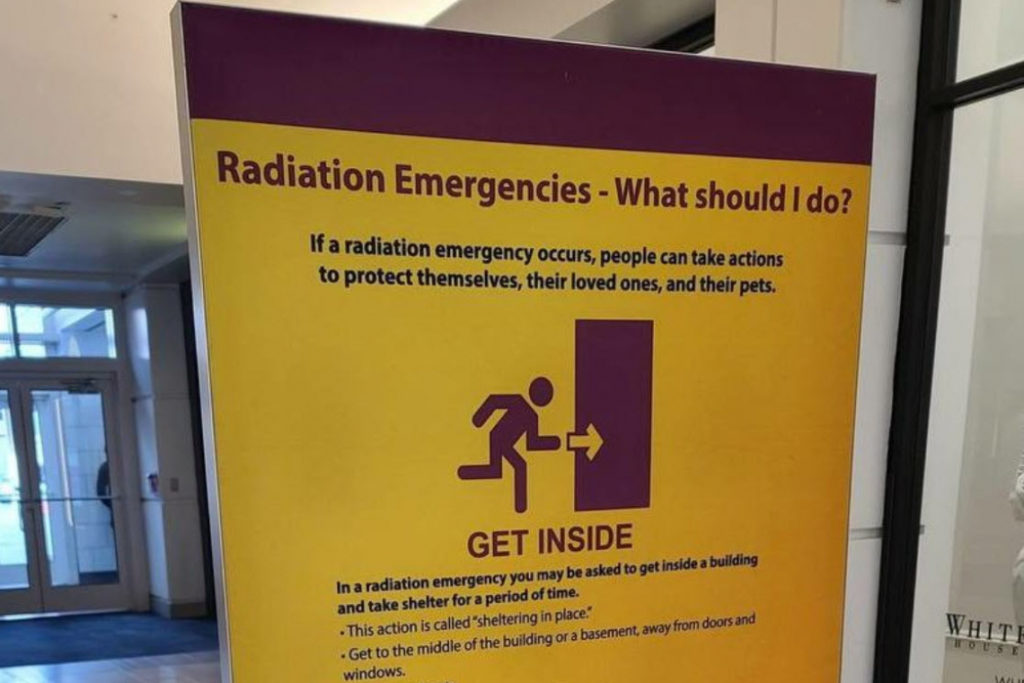
The Menlo Park Mall in Edison, New Jersey is just one of many large shopping malls in upscale areas publicly warning people about what to do if a Nuclear Bomb Hits! They have been told by government to begin warning people . . . because Nuclear War with Russia is not only a possibility, it has become a likelihood.
The horrifying reality that would be a nuclear blast is becoming so likely now over the Russia-Ukraine/NATO troubles in eastern Europe that governments and now private sector industries are warning people about what to do when a nuclear bomb goes off!
Below is a full image of warning signs now installed at the Menlo Park Mall in Edison, New Jersey:

These signs, and a new Public Service Announcement (PSA) from the New York City Office of Emergency Management which came out earlier this week (Story Here) are all instructing people that if a nuclear bomb goes off, GET INSIDE.
The reason this effort is underway is that government knows it has caused such terrible troubles with Russia, over the Ukraine situation, that it is now LIKELY we are going to be attacked by Russia with nuclear bombs.
MISINFORMATION
While the first trouble is, of course, that this is a problem of our government’s own making, the second major problem is that the advice is utterly stupid.
they tell people to get inside. Good advice . . . if there’s anything left standing to actually get inside of!
Russia uses the YARS intercontinental ballistic missile to launch nuclear attacks. Those missile are equipped with an eight-hundred kiloton (800kt) warhead.
The blast map below is a scientific model from Nuclear Secrecy.org showing the actual scientifically-modeled blast effects of a single, 800kt nuclear bomb air bursting over New York City.
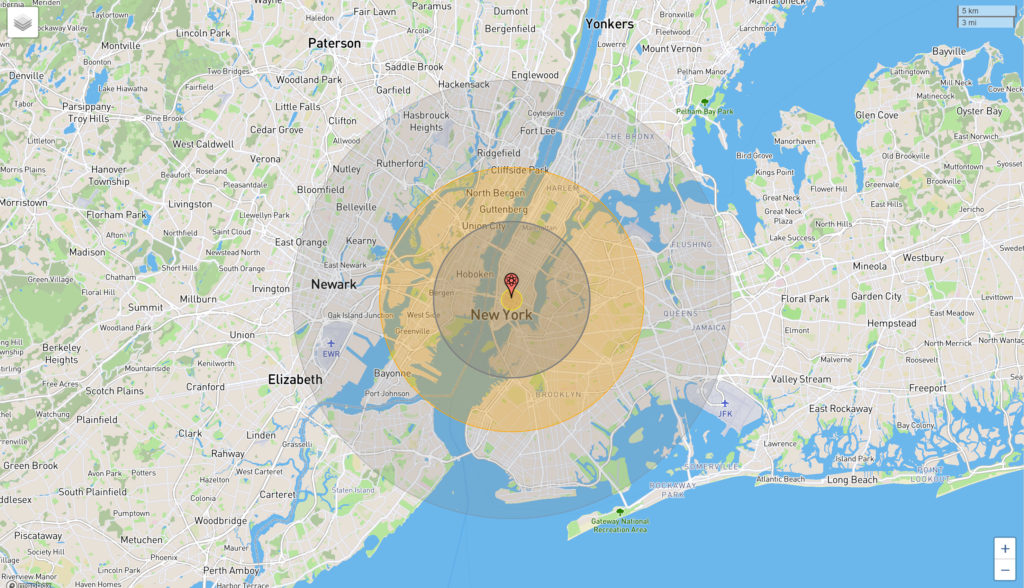
The inner smaller yellow area in the center show the initial blast area, all of which is vaporized. Absolutely nothing will be left. No people, no buildings, no vehicles. Nothing.
The next area is a grayish circular area. Everything in this area will be physically knocked down and on fire. Not even the strongest concrete and steel buildings will remain standing. And everything — all of it — will be on fire.
The next circular area toward the outer edges of the blast circle, will be THERMAL DAMAGE. Things in this area may be severely damaged or knocked down but SOME structures might remain standing as they erupt in flames. As for people in this area, anyone who was outside, and who sees the bright, white, flash, will have third-degree burns all over their body.
The final light gray area is where there will be light blast damage. Most structures will remain standing but windows are likely broken. People in this area will be injured from flying blast debris.
The signs then advise people “If you were outside when the blast hit, take off all clothes, shower and shampoo to wash the radiation off immediately.”
Trouble is THERE WON’T BE ANY RUNNING WATER. The water mains will be ruptured from the blast and the electric that powers the water pumps will all be off for miles.
But wait, there’s more . . . idiocy . . . . the signs tell people “stay tuned to local media and don’t go outside until authorities tell you it’s safe.” THERE WON’T BE ANY LOCAL MEDIA. It will all be blown up. All the TV and radio transmitters will be wiped out!
THERE WON’T BE ANY CELL PHONE SERVICE. The towers will all be knocked down, the transmitters fried by electro-magnetic pulse, and the electric will all be out. THERE WON’T BE ANY INTERNET SERVICE. All the Internet lines will be blown up and the wireless all offline from EMP or no electricity!!!
Yet even though the advice is utterly useless, the signs have gone up anyway.
Government doesn’t do things like this for no reason. They are putting out these PSA’s and asking large retailers to put these signs up because government KNOWS what’s coming. After all, it is government that is causing it all.
Unless Americans mobilize right now, and tell federal officials we will not tolerate them starting a nuclear war with Russia over Ukraine, we’re all dead.
You, me, our wives, husbands, kids, extended families . . . . will all be dead.
Pick up your phones and start swarming members of Congress and the Senate, telling them we refuse to allow them to start a nuclear war with their economic sanctions.
There is very little time left to act. It may already be too late.
But we have to put forth the effort or all of us will be killed.
The Battle of Saragarhi.

In the 1890s, the British were trying to conquer Afghanistan and it was becoming a severe challenge. As the Russians and Americans would learn, Afghanistan is not a place easily conquered.
A revolt breaks out towards the end of 1897 and Afgan tribesmen rally in the tens of thousands to the rebel banner. They begin to march towards British forts to push them out of their home.
Soon a rebel army arrives at a series of British forts and the fight begins.
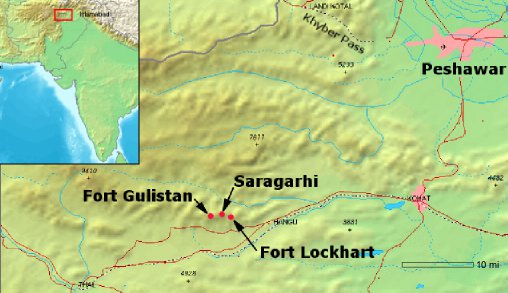
It’s the morning of September 12, 1897, and the British see an army on the horizon.
The British forces are locked away in Fort Lockhart and from there they see a massive army on the horizon—numbering some 10,000-12,000. The British are dangerously outnumbered and they prepare for a siege.
A signaling outpost some miles away, called Saragarhi, is manned by 21 Sikh warriors. The Sikhs are informed that an army numbering 10,000 is quickly approaching. The Sikhs request help, but the British inform them that they cannot assist, as they cannot leave the fort unguarded.
The Sikhs could run or surrender—the Afgan tribesmen would show them mercy. But the leader of these brave men, Ishar Singh, tells his men they will stay and fight.
The board up the gate, get ammunition stockpiled, and prepare to defend their small compound from an overwhelming force.
The Afgan army approaches and the fighting begins.
The Afghans send a massive charge to overwhelm the fort but disciplined and accurate rifle fire from the Sikh warriors is enough to break the charge and send the Afgan warriors running.
A second charge appears. This time the Afghans come in even greater numbers. The Sikh fire is unable to break the enemy lines and before too long, the Afgan tribesmen are climbing over the walls. A tough melee fight ensues with rifle butts, swords, and bayonets.
Again though the Sikhs hold, killing hundreds. They turn back the massive force and maintain control of the fort.
By this point, the Afgan forces have taken significant losses, considering this is a lightly manned signaling post. But several Sikhs have died as well.
Bhagwan Singh is the first to be killed in the fighting and his body is taken to the courtyard. Another warrior named Lal Singh is wounded and out of the fight.
One thing to note—this is all known not only from secondhand accounts but also the signalman, Gurmukh Singh. While all of this was happening he continued to send reports to the British at Fort Lockhart.
Now the Sikhs are down to 18 fighters the battle continues.
The Afgan army offers terms of surrender. They offer wealth, safety, power, and whatever else the Sikhs could want if they will just lay down their arms. The Sikhs boldly refuse.
The Afghans light fires to the hillside clouding everything in smoke. The signalman soon gets word that a formation of Afgan warriors is approaching the fort from the side, hidden by the smoke.
It’s too late—the Afgan warriors are in the compound.
Ishar Singh along with a few of his men charge the Afghans and another round of brutal hand-to-hand fighting breaks out inside the compound. The Sikhs are relentless and skilled, killing hundreds of attackers and holding their own despite being overwhelmed.
The Afghan warriors keep coming, though, and the Sikhs are being worn down. Pretty soon the outer walls crumble and the Afghans capture that portion of the compound.
Ishar Singh knows things are desperate. He orders his men back to the inner compound to mount a defense. He knows that if they turn their backs and run they will be cut down.
In a moment of utter bravery, Ishar Singh orders his men back and then single-handedly charges the approaching Afghan army. He cuts down warrior after warrior with his sword and pistol, cutting through the ranks of the surprised Afgan army.
After a few seconds, Ishar Singh is overwhelmed and killed—but he has bought his men the time they needed to fall back.
The Sikhs are now defending their fallback point, but the situation is hopeless. The Afghans start chopping at the wooden gate with axes and swords. Before too long they break through and thousands of them come pouring into what remains of the compound.
The Sikhs continue to fight bravely but hopelessly.
At this point, the signalman Gurmukh Singh signals the British to ask permission to abandon his post and take up his rifle. The order is approved and he calmly puts away his signal gear, takes up his rifle, and fixes the bayonet.
By now, he is the last living Sikh in the compound. The British look on as he moves to defend the door to the small building he was stationed in.
The door breaks and enemy charges in. The British watch in awe as Gurmukh Singh cuts down one, then two, then three, and then finally eighteen Afghan warriors. The men retreat and Gurmukh Singh continues to hold the building.
More charge in and he kills another twenty Afghans as the British cheer him on, watching his final battle from the fort using telescopes.
Alone and cut off, Gurmukh Singh killed 40 ENEMY WARRIORS in only a few minutes. What a total and complete you-know-what.
The Afghans are terrified by this. Unwilling to try and take the building again they set it on fire.
As the building burns, Gurmukh Singh shouts his battle cry over and over again.
“Bole so Nihal sat sri akal”
“Bole so Nihal sat sri akal”
“Bole so Nihal sat sri akal”
Shout aloud in ecstasy, true is the great timeless one.
The battle was over—the compound was taken and the Sikhs had lost.
Yet like Thermopylae and other hopeless battles, the deeds of these heroic and ferocious warriors live on in history as one of the great moments of bravery and valor.
The 21 Sikhs had sold their lives at a high cost. While all 21 died, they took 1,400 enemy soldiers with them while injuring thousands more. Estimates from most sources list 600-1400 fatalities, with many more wounded. Either way, these 21 men took a heavy toll on their enemy.
Every Sikh there that day killed 28-50 enemies. This is an insane feat and only shows how skilled and dedicated these men were.
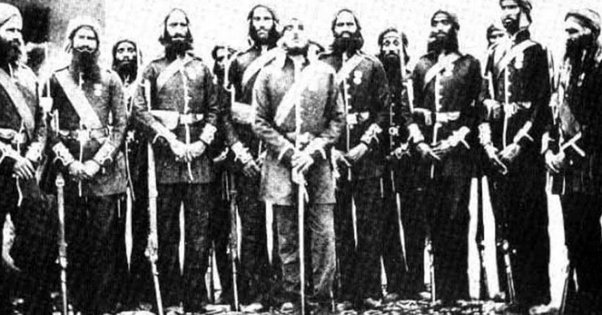
Marinated Tomatoes
Use up all those extra tomatoes with this easy make-ahead recipe – simply shake ingredients in a jar and pour over the fruit to marinate.

Ingredients
- 3 large or 5 medium fresh tomatoes, thickly sliced
- 1/3 cup olive oil
- 1/4 cup red wine vinegar
- 1 teaspoon salt, optional
- 1/4 teaspoon pepper
- 1/2 garlic clove, minced
- 2 tablespoons chopped onion
- 1 tablespoon minced fresh parsley
- 1 tablespoon minced fresh basil or 1 teaspoon dried basil
Some things I learned when I became old enough to get Social Security Insurance…
1. If you think you’re fat, you probably are.
2. Best friends see each other 3 times a year and may have no pictures together.
3. If you text, call, and still get ignored, just walk away.
4. Your hair was put on your head to remind you that you can’t control everything.
5. No one talks about how lonely healing can feel.
6. Don’t let your loneliness make you reconnect with wrong person. Meet better people here.
7. True relationship comes when the silence between you two is comfortable.
8. Go where your energy is reciprocated, celebrated, and appreciated.
9. You still haven’t met all of the people who are going to love you.
10. If today is not your day, remember there’re 365 days a year.
Sea Monkeys, X-Ray Specs, and the Twisted Secret Behind Vintage Ads from American Comic Books

American comics first came to Glasgow as ships’ ballast. In the sixties it seemed every other corner shop had a stash of these glossy-covered comics displayed on carousels or placed beside their tamer British counterparts like Beano, Topper, or Dandy. With comics like Thor, Hulk, Superman and co. it was difficult to keep collecting consecutive numbers as it was pot luck as to what arrived in the shop every month.

The clues were in the comic-book adverts for X-Ray specks, with which you could see the bones beneath your skin, or what was hidden under a layer of clothing; Sea Monkeys you could train who would entertain for hours; a mini-Polaris Nuclear Submarine with which to patrol local waterways; Aurora movie monster kits; and reinvent yourself like Charles Atlas or Arnold Schwarzenegger so no-one would kick sand in your face.




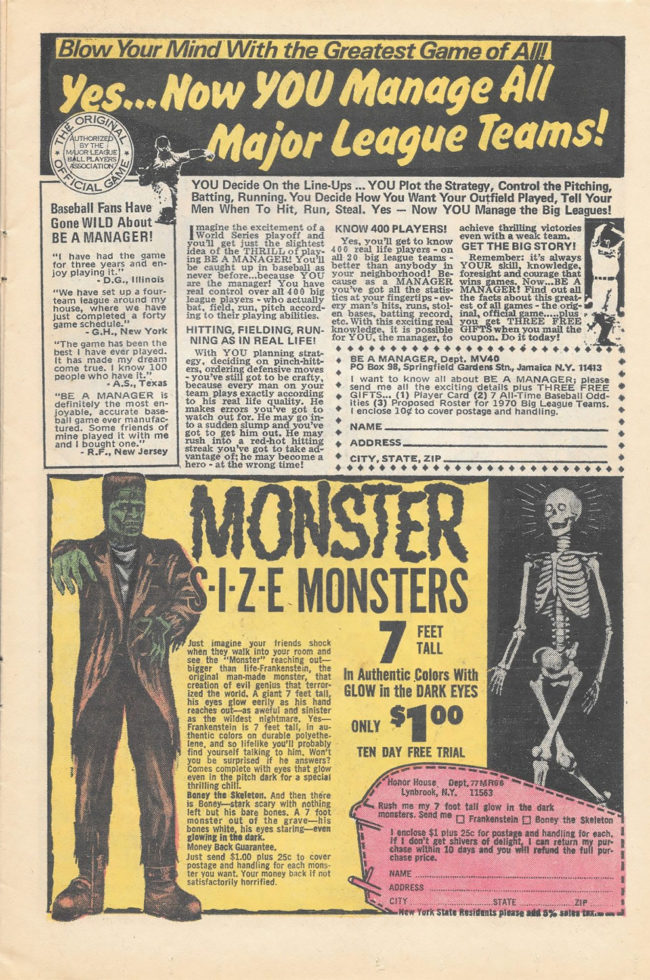






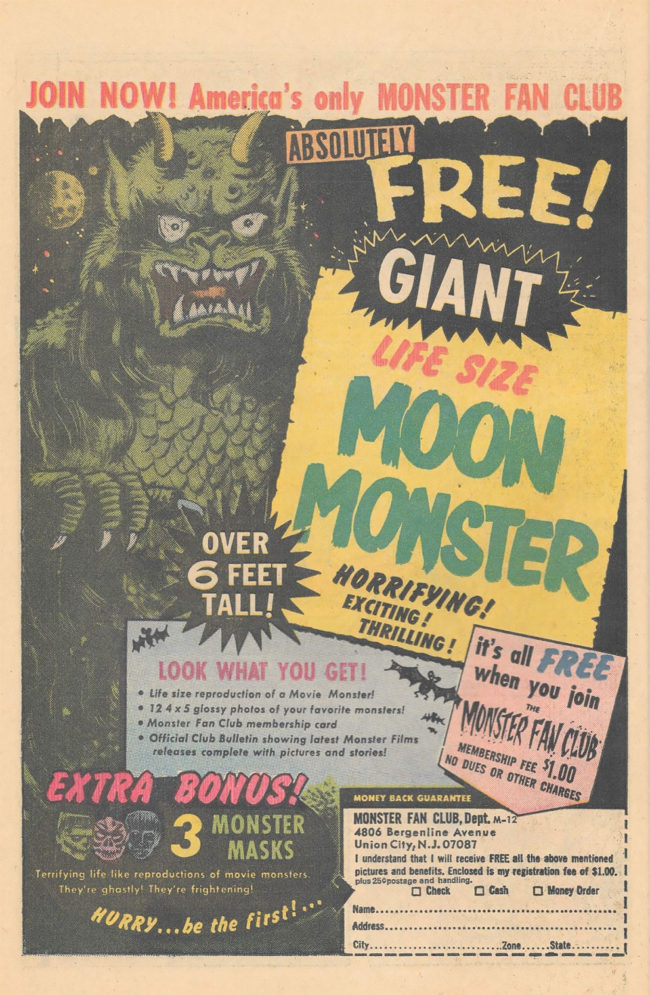
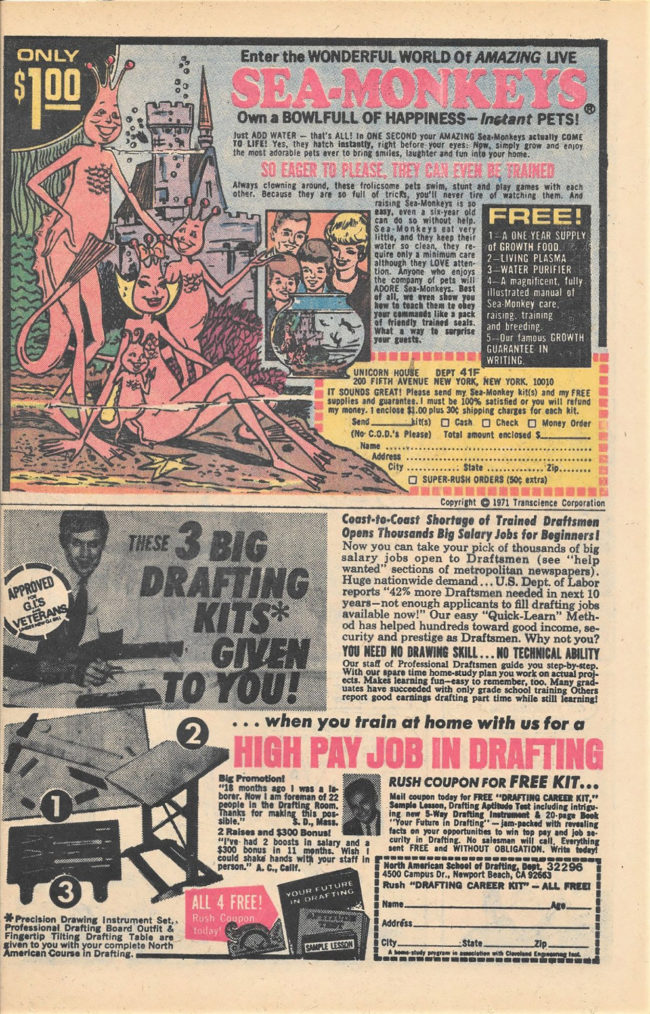
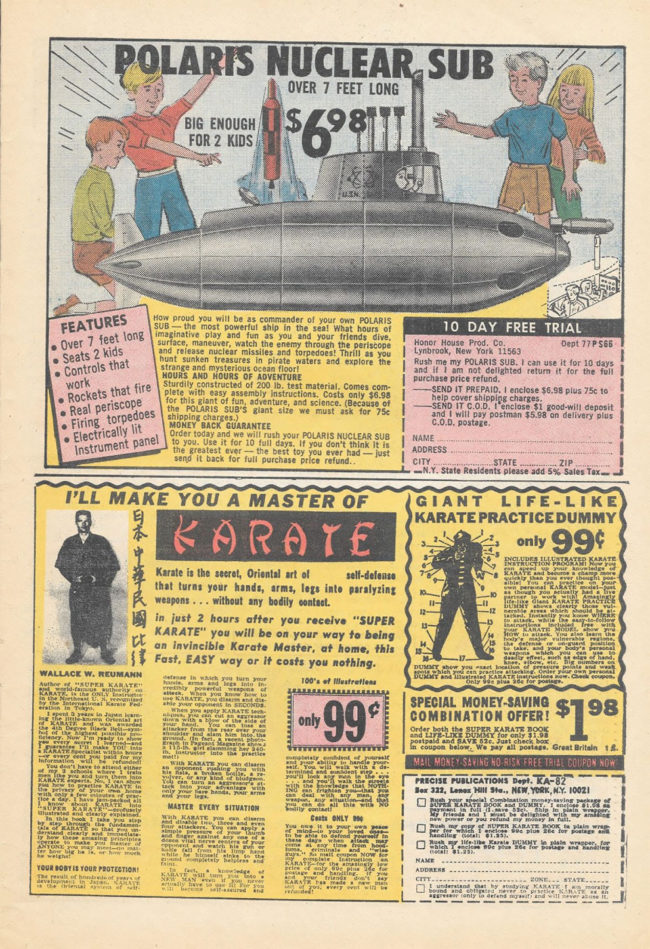









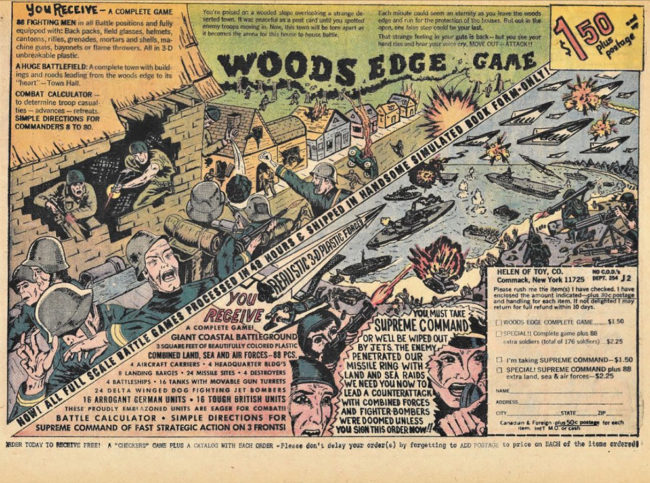



Do you want more?
You can find more articles related to this in my latest index; A New Beginning. And in it are elements of the old, some elements regarding the transition, and some elements that look towards the future.
New Beginnings 4.
Articles & Links
Master Index.
- You can start reading the articles by going HERE.
- You can visit the Index Page HERE to explore by article subject.
- You can also ask the author some questions. You can go HERE to find out how to go about this.
- You can find out more about the author HERE.
- If you have concerns or complaints, you can go HERE.
- If you want to make a donation, you can go HERE.
.


